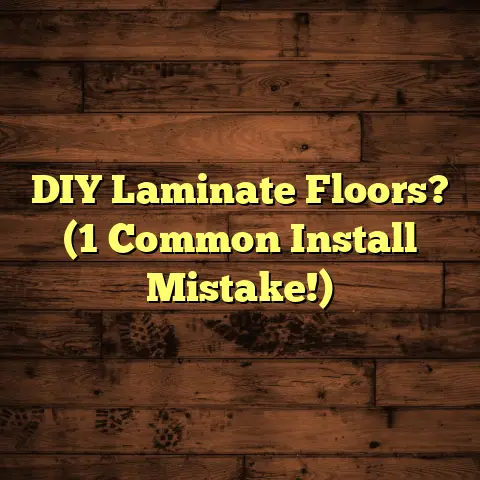Laminate Flooring: Waterproof? (Don’t Be Fooled!)
Let’s talk floors. But before we dive into the nitty-gritty of laminate, let’s address something super important: allergies.
Think about it: dust mites, mold spores, pet dander – these tiny irritants can turn your home into an allergy nightmare.
Indoor air quality is a big deal, and your flooring plays a surprisingly large role.
That’s why choosing the right flooring isn’t just about looks; it’s about your health.
Now, laminate flooring. It’s everywhere, right?
It’s affordable, looks great (sometimes!), and many claim it’s easy to install.
But here’s the million-dollar question: Is laminate flooring really waterproof?
Or is that just a clever marketing ploy?
As a flooring contractor who’s seen it all, I’m here to tell you: don’t be fooled!
Understanding Laminate Flooring
So, what exactly is laminate flooring?
Well, picture a multi-layered cake.
Laminate is kinda like that, but instead of frosting and sponge, we’ve got:
-
Wear Layer: The top layer, tough and transparent, protects against scratches and stains.
-
Design Layer: This is where the magic happens – a high- resolution image that mimics wood, stone, or tile. It’s what gives laminate its look.
-
Core Layer: The heart of the laminate, usually made of high-density fiberboard (HDF) or medium- density fiberboard (MDF).
This layer provides stability and resistance to impact.
-
Backing Layer: The bottom layer, designed to protect the core from moisture and provide a stable base.
How is this layered cake made?
The layers are fused together under high pressure and heat.
This process creates a durable and relatively inexpensive flooring material.
You’ll find different types of laminate out there.
Some are thicker, some have enhanced wear layers, and some are designed for specific environments.
For example, a busy commercial space needs a different laminate than a quiet bedroom.
The Claim of Waterproof Laminate Flooring
Okay, let’s get to the juicy part.
You’ve probably seen the ads: “Waterproof Laminate!” “Spill-Proof Flooring!”
But what do these claims really mean?
First, let’s clarify some terminology.
Water-resistant means the material can resist water penetration to some degree, for a limited time.
Think of it like a raincoat – it’ll keep you dry in a drizzle, but not a downpour.
Waterproof, on the other hand, implies that the material is impervious to water, no matter how long it’s exposed.
Big difference, right?
Traditional laminate flooring is not waterproof.
The core layer, usually made of HDF or MDF, is highly susceptible to water damage.
If water seeps in, the core can swell, warp, and even delaminate (separate into layers).
However, newer waterproof laminate options have emerged in recent years.
These advancements involve using different core materials, such as a waterproof polymer composite, and tighter locking systems to prevent water from penetrating between planks.
So, how do manufacturers test their “waterproof” claims?
They typically subject the laminate to controlled water exposure for a certain period.
For example, they might submerge a sample in water for 24 hours and then check for swelling or damage.
But here’s the catch: these tests don’t always replicate real-life conditions.
A controlled lab environment is very different from a flooded bathroom or a leaky dishwasher.
I’ve seen “waterproof” laminate fail in real-world scenarios more times than I can count.
According to a 2023 report by Consumer Reports, while some waterproof laminates performed well in lab tests, many still showed signs of water damage after prolonged exposure in actual homes.
This is especially true in areas with high humidity or frequent spills.
The Reality of Moisture and Laminate Flooring
Moisture is laminate flooring’s kryptonite.
Even if you opt for a “waterproof” variety, excessive moisture can still cause problems.
Warping, swelling, and delamination are common issues.
I remember one case where a homeowner installed “waterproof” laminate in their bathroom.
A small leak under the toilet went unnoticed for a few weeks.
By the time they discovered the problem, the laminate around the toilet was completely ruined.
It had swollen so much that it had to be replaced.
And it wasn’t a cheap fix.
Another client installed laminate in their basement, thinking it would be a cost- effective solution.
But basements are notorious for moisture, and even with a vapor barrier, the laminate eventually buckled and warped due to humidity.
Proper installation is also crucial.
If the subfloor isn’t level or if the planks aren’t properly locked together, water can seep in and cause damage.
Gaps around the edges of the room are also vulnerable spots.
Maintenance is key. Wipe up spills immediately, use doormats to prevent dirt and moisture from being tracked in, and consider using a dehumidifier in damp areas.
The Misconceptions Surrounding Waterproof Claims
One of the biggest misconceptions is that “waterproof” laminate is impervious to all forms of moisture.
People often assume that it can withstand anything from a spilled glass of water to a major flood.
That’s simply not true.
While some waterproof laminates can handle small spills and splashes, they’re not designed to be submerged in water for extended periods.
Humidity is another factor that’s often overlooked.
Even if you don’t have any visible leaks or spills, high humidity can still damage laminate flooring over time.
This is especially true in bathrooms and basements.
Consumer education is vital.
Read product labels carefully and don’t rely solely on marketing claims.
Understand the difference between water- resistant and waterproof, and ask specific questions about the product’s limitations.
The implications of these misconceptions can be significant.
Families with allergies may choose laminate thinking it’s a low-maintenance, allergy- friendly option, only to find that it harbors mold and mildew when exposed to moisture.
People living in humid climates may install laminate in areas where it’s simply not suitable, leading to costly repairs and replacements.
Alternatives to Laminate Flooring for Allergy Sufferers
So, if laminate isn’t the best choice for allergy sufferers or moisture-prone areas, what are the alternatives?
Here are a few options:
-
Tile: Tile is waterproof, durable, and easy to clean. It’s a great choice for bathrooms, kitchens, and basements. However, tile can be cold and hard underfoot, and grout can be difficult to maintain.
-
Luxury Vinyl: Luxury vinyl plank (LVP) and luxury vinyl tile (LVT) are excellent alternatives to laminate. They’re waterproof, scratch- resistant, and come in a wide range of styles. LVP and LVT are also softer and warmer than tile.
-
Engineered Hardwood: Engineered hardwood is a good option if you want the look of real wood but need something more moisture-resistant than solid hardwood. Engineered hardwood has a thin layer of real wood on top of a plywood or HDF core. While it’s more resistant to moisture than solid hardwood, it’s still not waterproof.
Each of these options has its pros and cons.
Tile is the most waterproof but can be cold.
Luxury vinyl is a great all-around choice.
Engineered hardwood offers the look of real wood but requires more care.
Ultimately, the best choice depends on your specific needs and preferences.
Conclusion
Let’s recap.
Laminate flooring is a popular choice for many homeowners, but it’s essential to understand its limitations, especially when it comes to moisture.
While “waterproof” laminate options are available, they’re not impervious to all forms of moisture, and they may not perform as well in real-world conditions as they do in lab tests.
For allergy sufferers and those living in moisture-prone areas, alternative flooring options like tile, luxury vinyl, and engineered hardwood may be better suited.
When selecting flooring materials, it’s crucial to make informed choices based on your specific needs and environment.
Don’t rely solely on marketing claims, and always read product labels carefully.
And remember, I’m here to help!
If you’re unsure about which flooring is right for you, don’t hesitate to seek professional advice.
A qualified flooring contractor can assess your needs, recommend the best options, and ensure proper installation.
So, do your research, ask questions, and choose wisely.
Your floors will thank you for it!





